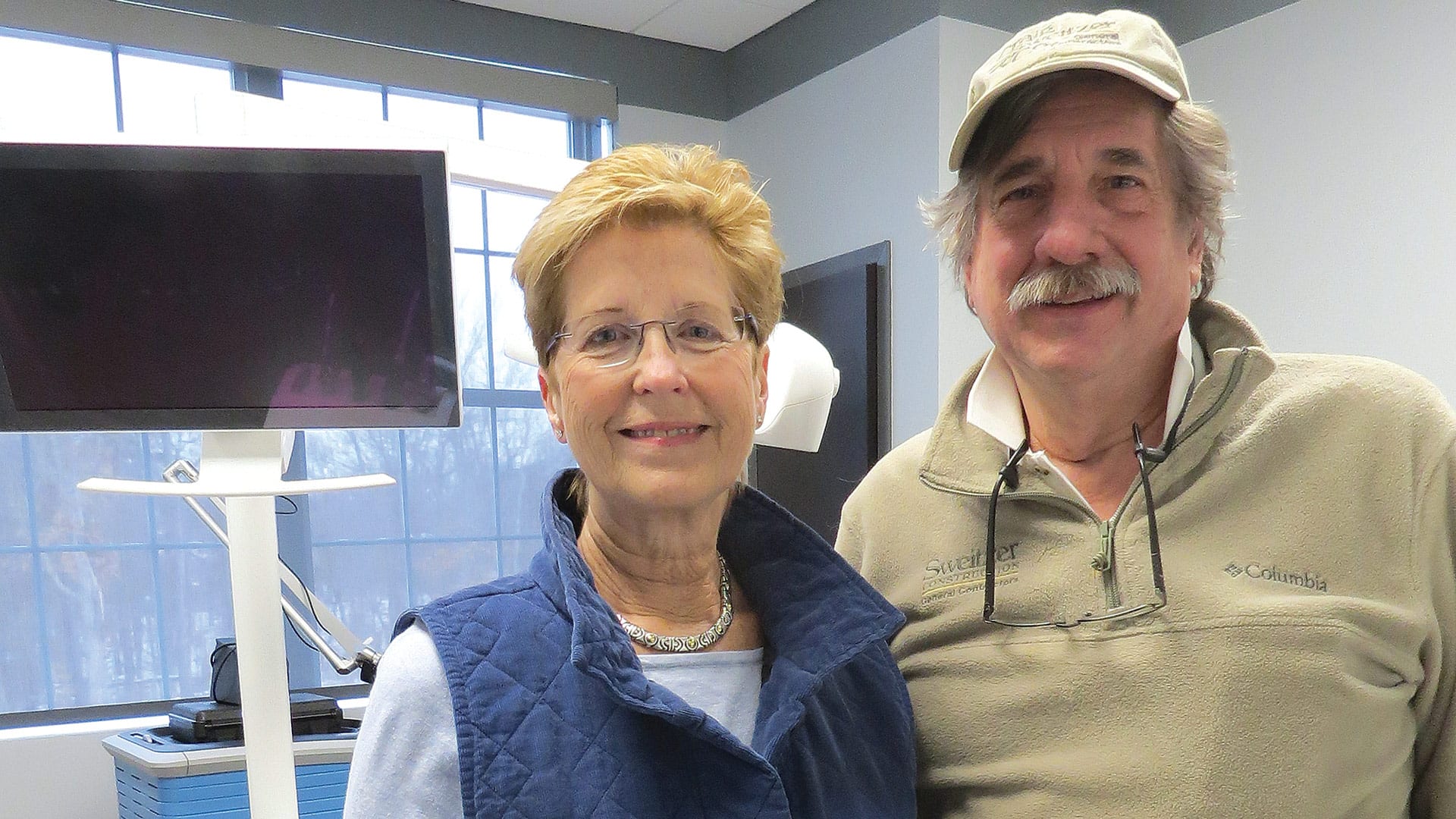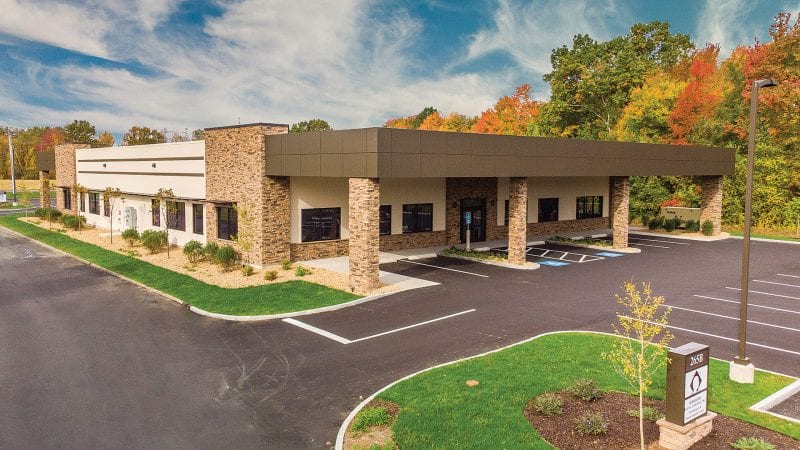Healthcare Construction Is Picking Up, but Questions Remain
Building Momentum
By George O’Brien

Ryan Pelletier says that, while it was “scary at times,” he believes life has returned to something approaching normal — although ‘normal’ is certainly a relative term — when it comes to construction within the broad and all-important healthcare sector in Western Mass.
And he should know. He’s project manager for Houle Construction in Ludlow, a family-run operation (his father, Tim, is president) that does the bulk of its work within the healthcare sector, including projects for most area hospitals and a number of private practices as well.
He told HCN that things were busy just after COVID-19 arrived in the 413 almost exactly a year ago, as a number of hospitals and other providers needed some retrofitting of sorts and other types of work to do battle with the pandemic, but then, things got quiet in a hurry and stayed that way for a while, before starting to revert to something akin to pre-pandemic conditions.
“We’ve seen steel and lumber costs rise exponentially — they’ve almost doubled within the past year.”
“We were very busy for a few weeks, and then … it just died,” said Pelletier, referring to the early months of the pandemic, and noting that hospitals and private practices simply didn’t want more people on site than absolutely needed to be there. “But in the last several months, things have started to come back. There’s a comfort level now — the hospitals and private practices are getting back to business as usual, or as usual as they can.”
But that word ‘scary’ was used in reference to much more than the number of projects in the pipeline. Indeed, it also referred to everything from the daunting task of keeping employees — and everyone else on a job site — safe to the cost and availability of materials.
And he was not alone in that assessment, especially when it comes to the price hikes.

“We’ve seen steel and lumber costs rise exponentially — they’ve almost doubled within the past year,” said Dan Bradbury, director of Sales and Marketing for South Hadley-based Associated Builders, which works within a number of sectors, including healthcare. He noted that these rising costs could, and probably will, impact everything from decisions on whether projects move forward in the near term to what kind of construction takes place — new or renovation of existing space (more on all that later).
As for now and the immediate future, those we spoke with said that, after going mostly and then almost completely silent in the weeks after COVID hit, the phones are starting to ring again with greater regularity — in general, and within the healthcare sector in particular.
Pat and Craig Sweitzer, co-owners of Monson-based Swietzer Construction, which specializes in healthcare construction and especially dental offices, said they have a number of projects in progress and on the books, including three new dental offices, a medical building with a dental office as part of the lineup, two new medical spas (including one in East Longmeadow, adjacent to an Ascent Dental office they built), a cannabis dispensary, and work at Adaptas Solutions in Palmer, which is now making parts for COVID testing.
Noting how he needs to be at a number of different sites on a weekly of not daily basis, Craig Sweitzer joked, “I need to buy an airplane.”
Those sentiments express just how much the market has rebounded — if that’s even the right word — and how the outlook has brightened since the darkest days of the pandemic.
Download a list of General Contractors in Western Mass.
Bradbury agreed. “Especially in this new year, 2021, there’s been a more positive outlook, and we’re starting to have the phone ring more and see more potential jobs in the pipeline for this year and for next,” he said, adding that this sentiment applies, again, to construction in general and healthcare construction more specifically.
But there are still many question marks about just what the future will bring, and for this issue and its focus on healthcare construction and real estate, we talked with these experts about what can and likely will happen, both short- and long-term.
Concrete Examples
Rewinding the tape on the past 12 months of COVID, those we spoke with echoed the sentiments of business owners and managers in every sector when they said the changing landscape brought with it both challenges and opportunities, and certainly more of the former.
Indeed, some construction projects in the healthcare sector were put on the shelf because of the way the pandemic impacted the client in question financially. Meanwhile, and especially in the beginning, it brought about some new work, as Pelletier explained.
“When COVID first hit, the hospitals were scrambling to get prepared for potential overflow — spikes and surges — and they wanted us to help them with that, whether it was installing plexiglass shields or building out existing spaces in their facilities to house incoming patients,” he explained. “We had to work around the clock, and it was a little nerve-wracking at first because no one was quite sure what COVID was and how dangerous it was — and they were asking us to send our guys out there not knowing exactly what they were getting into, and the crews had mixed feelings.”
Again, opportunities and challenges.

The challenges came in waves and in different forms, from meeting the many new regulations and protocols regarding when and how work can be done to handling new and different employee needs — from more sick time, if needed, to PPE, to working in settings that were often the front lines of the COVID crisis.
The opportunities have come in various forms as well, and sometimes unexpectedly. That was certainly with the case with Adaptas Solutions.
“They’ve kept us quite busy through all this because they’ve been ramping up and needed construction facilities to accommodate the work they were doing,” said Pat Sweitzer, adding that the company has some projects ongoing there.
Meanwhile, the airplane the company doesn’t have yet would also be going to several other projects across the region, the sum of which adds up to what Pat described as a fairly typical year, volume-wise.
What isn’t as typical is the nature of the work being undertaken, said Craig, noting that COVID has changed the way facilities are designed and operated, with additional emphasis on HVAC and, more specifically, air movement and air quality.
“Dental offices are ground zero — these are individuals working in a patient’s mouth, which is the means for transmitting COVID,” he explained. “These doctors and their hygienists are at ground zero as far as risk is concerned, so we’ve paying a lot of attention to our design/build criteria.
“And the lion’s share of that goes back to HVAC, so we’ve redesigned our standard operatory,” he went on, adding that, with these redesigns, instead of air being drawn up from the patient’s mouth past the doctor, it is drawn down to the floor, into the ductwork and away from the doctor’s face.
The company is also installing UVC systems, which kill COVID; additional air changers; larger, tighter air filters; and, increasingly, washers and dryers so staff can wash their clothes during the day.
“We’ve really been refining how we lay these design/build projects out,” Pat said, noting that the modern dental office now resembles a hospital operating room in many respects.
Looking ahead, those we spoke with said COVID will likely continue to impact the healthcare construction scene, even if the pandemic eases, as most project that it will.
Indeed, there is general uncertainty about when or even if the rising prices on materials will start to ease, and this uncertainty could play a role in whether some projects move forward or not.
Bradbury told HCN there is inclination among some in healthcare (and in other sectors, obviously) to try to wait these increases out with the hope that prices will start coming down.
“But there is no guarantee that prices will come down,” he said. “One thing I always tell people is that, while they think they can wait out the increases in materials costs, there are never any guarantees that they will, so we encourage people to move forward with projects — if it fits their timeline and their budget, because there are no guarantees.”
Meanwhile, COVID will likely impact the healthcare construction market in another way, said those we spoke with, specifically the lasting impact it seems destined to have on the real-estate market. Even when COVID eases, they said, it seems almost certain that some companies will settle into smaller spaces as more people work at home, bringing more commercial real estate onto the market, which will, in turn, impact new construction.
“Renovating existing space is almost always less expensive than building new, especially when you consider those amazing price increases we’re seeing,” Bradbury said. “A lot of our business is new construction, and we’re contending with a lot of empty office space; long-term, there will be more available office space to lease on the market, which, across some industries, will tamp down new construction, but it will bring an opportunity for more build-out and renovation of existing space.”
Bottom Line
Looking back, and ahead, those we spoke with said a sense of normal — or a new normal (there’s that phrase again) — is returning to the healthcare construction scene.
But there are many question marks still looming over the scene and a number of variables that could impact how much work and what kinds of projects move into the pipeline.
There has been a great deal of pivoting over the past year — for the construction firms and their clients as well — and there is certainly more to come.
But for now, momentum is building in a number of ways.




